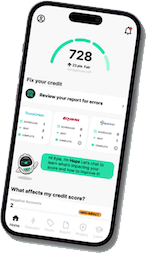Understanding Your 596 Credit Score

Got a 596 credit score? You’re not alone—and you’re not stuck. This guide breaks down what your score means, how lenders view it, what financial moves are still on the table, and the best ways to start building better credit. Whether you’re rebuilding or just getting started, real progress is possible.
A 596 credit score may not be ideal, but it’s more common than you might think. It sits in the range where you can start making meaningful changes.
Here’s a helpful guide to help you understand what your credit score means, what you can do with it, and how to improve it!

Is a 596 Credit Score Good or Bad?
A 596 score usually falls into the fair category, though some scoring models might consider it poor credit—it really depends on which system is being used.
When a lender checks your credit report, they’re not just looking at the number. They’re evaluating your full credit history, including your payment history, how many credit card accounts you have, and whether you’re carrying existing balances that seem too high. A lower credit score like 596 may mean fewer approvals, higher interest rates, and stricter terms.
Still, you’re not locked out of the system. You just need to know how to work with what you have.
How FICO and VantageScore Define a 596
Here’s where a 596 credit score lands:
- FICO® Score: 580–669 = Fair credit score
- VantageScore®: 300–660 = Poor to fair
Most lending decisions are based on FICO scores, but VantageScore is often what you see in credit monitoring apps.
Any time you apply for credit, it’s likely a hard inquiry will be recorded. But when you check your own score or get prequalified, that’s a soft inquiry and won’t impact your score.
How Your Score Stacks Up Against the Average
Right now, the average credit score in the US sits around 715. So yes, 596 is below average—but that doesn’t mean you’re stuck. Plenty of people have climbed from the 500s to the 700s by building good habits and staying consistent.
What You Can Do with a 596 Credit Score
Even with a 596, you still have credit options—you just need to start with beginner-friendly tools.
You may not qualify for premium cards or lower interest rates, but you can still take steps forward. Think of it like: it’s not first class, but you can still board the plane.
Credit Cards
A secured credit card is a good place to start. It requires a refundable deposit, which sets your total credit limit. Used wisely, it helps build credit history and strengthen your credit accounts. Look for cards that report to all three major credit bureaus, have low or no annual fees, and offer upgrade paths.
Car/Personal Loans
You may qualify, but lenders see you as higher risk. Expect higher interest rates, stricter loan terms, or smaller loan amounts. Prequalify to avoid multiple hard inquiries, and consider lenders offering installment loans for rebuilding credit.
Rent and Mortgage
You can rent or buy, but landlords and lenders may want more than just your score. They might ask for a co-signer, higher deposit, or review your full credit history and lender reports. Some also consider steady income and positive rental history, especially if you’re working to build credit.
What’s Bringing Down a 596 Credit Score?
A 596 credit score usually doesn’t come out of nowhere—it’s often the result of patterns or habits that build up over time. Here are a few factors that could be contributing to a 596:
Late or Missed Payments
Just one missed payment can damage your good payment history and stay on your credit reports for up to seven years.
Pro tip: Set up automatic payments or calendar alerts to avoid slips. Timely bill payments are one of the fastest ways to show lenders you’re trustworthy, while also improving your score.
High Credit Usage
Your credit utilization rate reflects how much credit you’re using compared to your available credit. If you’re using too much—especially on revolving credit—it can hurt your score.
For example, if you have a $1,000 credit limit and carry a balance of $800, that’s 80% usage. Yikes. Aim to use less than 30% of your available credit, and if possible, stay under 10% to support healthier credit scores.
Limited or Thin Credit File
Not having a diverse credit mix—a balance of different credit types like credit cards, loans, or lines of credit—can hurt your credit health. Scoring models also consider the average age of your credit accounts, so longevity matters too.
To strengthen your credit profile:
- Become an authorized user on someone else’s card
- Apply for a secured credit card
- Open a credit builder loan to add variety and history over time
How to Improve a 596 Score (And See Real Results)
Credit improvement isn’t instant, but it is possible. Let’s focus on healthy credit habits that lead to progress.
Pay All Your Accounts on Time
A positive payment history strengthens your score. Even one missed due date can cause damage. Our advice? Set it and forget it with autopay. When you consistently pay your bills on time, you’re building the kind of positive credit history lenders trust.
Lower Your Existing Credit Card Balances
If your cards are maxed out, your credit utilization ratio is likely high. Paying down revolving credit is one of the quickest ways to raise your score. This has a positive impact on both your FICO score and VantageScore.
Don’t Apply for a Bunch of New Credit
Too many credit applications in a short time signals risk. Each hard inquiry can shave off a few points. Instead, focus on building slowly with one or two solid credit cards or loans.
Open a Secured Card or Credit Builder Loan
Each time you apply, a hard inquiry hits your report. Too many? Lenders may see you as desperate or risky. Stick to soft inquiries when browsing offers, and only submit credit applications when you’re confident. These tools are especially helpful if you’re starting with poor credit or trying to rebuild after financial setbacks.
Become an Authorized User on Someone Else’s Credit Card
Yes, this can be your parent’s or friend’s card—with permission. You don’t have to use it to benefit from their good history. It’s a low-risk way to pad your credit profile.
Be Cautious with Credit Repair Companies
Some credit repair companies are legit. Others, not so much. Be cautious of promises to “erase bad credit instantly.” You can handle credit report disputes with the credit bureaus directly, or use reputable tools like Dovly AI for extra assistance.
How Long Does It Take to Go from 596 to a Good Credit Score?
Improving your credit score from 596 won’t happen overnight, but with steady effort and good credit habits, you can see noticeable progress within a few months. Whether you’re tackling high credit utilization by paying down balances and opening a secured card, catching up on late payments with consistent on-time payments, or building your credit file by adding new accounts thoughtfully, patience and persistence are key. Keep monitoring your credit reports, stay consistent, and over time, your score will improve.

Final Thoughts: 596 Isn’t the End—It’s the Start
A 596 credit score is a sign—it’s time to build. With healthy credit habits, smarter decisions, and a little patience, you can change the trajectory.
Start with what you control: timely payments, low usage, and consistent effort.
And if you need help taking the guesswork out of it, Dovly AI is designed to help you track, fix, and improve your credit—faster and smarter. You don’t have to do it alone.
Let’s take the next step toward stronger credit—starting today.
Frequently Asked Questions


